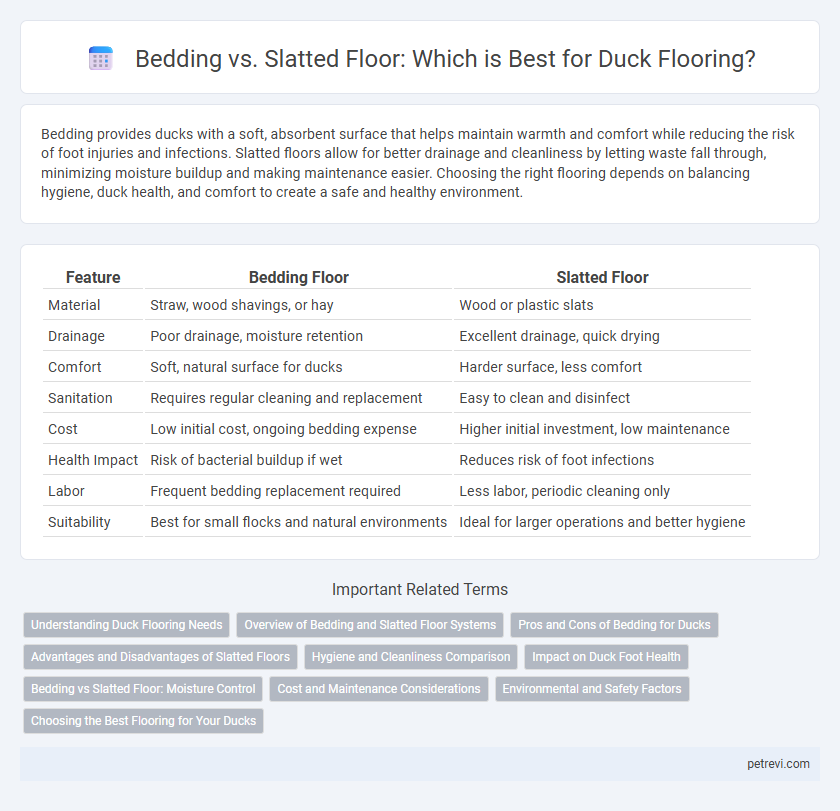Bedding provides ducks with a soft, absorbent surface that helps maintain warmth and comfort while reducing the risk of foot injuries and infections. Slatted floors allow for better drainage and cleanliness by letting waste fall through, minimizing moisture buildup and making maintenance easier. Choosing the right flooring depends on balancing hygiene, duck health, and comfort to create a safe and healthy environment.
Table of Comparison
| Feature | Bedding Floor | Slatted Floor |
|---|---|---|
| Material | Straw, wood shavings, or hay | Wood or plastic slats |
| Drainage | Poor drainage, moisture retention | Excellent drainage, quick drying |
| Comfort | Soft, natural surface for ducks | Harder surface, less comfort |
| Sanitation | Requires regular cleaning and replacement | Easy to clean and disinfect |
| Cost | Low initial cost, ongoing bedding expense | Higher initial investment, low maintenance |
| Health Impact | Risk of bacterial buildup if wet | Reduces risk of foot infections |
| Labor | Frequent bedding replacement required | Less labor, periodic cleaning only |
| Suitability | Best for small flocks and natural environments | Ideal for larger operations and better hygiene |
Understanding Duck Flooring Needs
Duck flooring with bedding materials like straw or wood shavings provides better insulation and natural comfort, promoting healthier foot conditions and reducing stress. Slatted floors offer enhanced drainage and cleanliness, minimizing moisture buildup and preventing bacterial growth, crucial for maintaining duck hygiene. Choosing the right flooring depends on balancing moisture control, comfort, and ease of cleaning to meet the specific welfare needs of ducks.
Overview of Bedding and Slatted Floor Systems
Bedding systems for duck flooring typically use materials like straw, wood shavings, or rice hulls to provide comfort, insulation, and moisture absorption, promoting better health and natural behaviors. Slatted floor systems consist of raised platforms with gaps that allow droppings to fall through, enhancing cleanliness and reducing footpad injuries while requiring careful management to prevent litter buildup beneath. Choosing between bedding and slatted floors depends on factors such as flock size, ventilation, and ease of maintenance to optimize duck welfare and farm efficiency.
Pros and Cons of Bedding for Ducks
Bedding for duck flooring provides a soft, absorbent surface that helps maintain dry conditions and reduces the risk of foot infections such as bumblefoot. However, it requires regular replacement to prevent ammonia buildup and can harbor parasites if not properly managed. Compared to slatted floors, bedding offers better insulation and comfort but demands more maintenance and higher costs.
Advantages and Disadvantages of Slatted Floors
Slatted floors in duck housing provide superior drainage and cleanliness by allowing waste to fall through the gaps, reducing moisture buildup and the risk of disease. However, these floors can cause discomfort or injury to ducks' feet due to uneven surfaces or inappropriate slat spacing, potentially leading to stress or leg problems. Maintenance requires regular checks to prevent clogging and ensure structural integrity, balancing hygiene benefits against animal welfare concerns.
Hygiene and Cleanliness Comparison
Bedding provides better absorption of moisture and droppings, helping to maintain a drier and cleaner environment for ducks, which reduces the risk of bacterial growth and foot infections. Slatted floors allow droppings to fall through, making waste removal easier and improving overall hygiene, but inadequate spacing can trap dirt and cause discomfort to ducks. Regular cleaning and proper maintenance are essential for both flooring types to ensure optimal hygiene and prevent health issues in duck housing.
Impact on Duck Foot Health
Bedding materials like straw or wood shavings provide a soft, cushioned surface that reduces pressure and prevents footpad lesions in ducks, promoting healthier feet and minimizing infections like pododermatitis. Slatted floors, while allowing better drainage and cleanliness, can create uneven pressure points and abrasive contact, increasing the risk of foot injuries and discomfort. Optimal duck flooring balances hygiene with foot comfort to sustain robust foot health and prevent long-term mobility issues.
Bedding vs Slatted Floor: Moisture Control
Bedding for duck flooring absorbs moisture, helping keep the environment dry but requires frequent changing to prevent mold and bacteria buildup. Slatted floors allow waste and moisture to fall through gaps, enhancing ventilation and reducing direct contact with damp surfaces, which improves overall hygiene. Proper moisture control with slatted floors minimizes duck foot diseases, while bedding must be managed more carefully to avoid excessive dampness.
Cost and Maintenance Considerations
Bedding flooring for ducks typically involves straw or wood shavings, which provide comfort but require frequent replacement, increasing long-term maintenance costs. Slatted flooring is more durable and allows better waste drainage, reducing cleaning time but often comes with higher initial installation expenses. Choosing between bedding and slatted floors depends on balancing upfront investment against ongoing labor and material costs for optimal duck housing.
Environmental and Safety Factors
Bedding for duck flooring offers enhanced insulation and temperature regulation, reducing stress and promoting natural behaviors such as foraging. Slatted floors improve waste drainage, minimizing ammonia buildup and reducing the risk of respiratory issues and foot lesions. Environmental impact favors bedding for its biodegradability and potential for composting, while slatted floors require more intensive cleaning and maintenance to prevent pathogen accumulation.
Choosing the Best Flooring for Your Ducks
Selecting optimal flooring for ducks involves comparing bedding and slatted floor options based on comfort, hygiene, and durability. Bedding, often straw or wood shavings, offers warmth and natural cushioning but requires frequent replacement to prevent moisture buildup and bacterial growth. Slatted floors promote superior drainage and cleanliness by allowing waste to fall through, reducing disease risk, though they may necessitate softer resting areas to prevent foot injuries.
Bedding vs Slatted Floor for Duck Flooring Infographic

 petrevi.com
petrevi.com